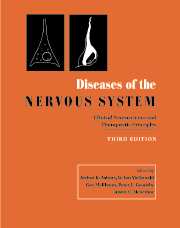Book contents
- Frontmatter
- Dedication
- Contents
- List of contributors
- Editor's preface
- PART I INTRODUCTION AND GENERAL PRINCIPLES
- PART II DISORDERS OF HIGHER FUNCTION
- PART III DISORDERS OF MOTOR CONTROL
- 31 Mechanisms of motor control
- 32 The apraxias
- 33 Parkinson's disease
- 34 Other extrapyramidal syndromes: parkinsonism-plus and other forms of secondary parkinsonism
- 35 Tremors
- 36 Myoclonus
- 37 Dystonia
- 38 Tourette syndrome
- 39 Cerebral palsy
- 40 Gait and balance disorders
- PART IV DISORDERS OF THE SPECIAL SENSES
- PART V DISORDERS OF SPINE AND SPINAL CORD
- PART VI DISORDERS OF BODY FUNCTION
- PART VII HEADACHE AND PAIN
- PART VIII NEUROMUSCULAR DISORDERS
- PART IX EPILEPSY
- PART X CEREBROVASCULAR DISORDERS
- PART XI NEOPLASTIC DISORDERS
- PART XII AUTOIMMUNE DISORDERS
- PART XIII DISORDERS OF MYELIN
- PART XIV INFECTIONS
- PART XV TRAUMA AND TOXIC DISORDERS
- PART XVI DEGENERATIVE DISORDERS
- PART XVII NEUROLOGICAL MANIFESTATIONS OF SYSTEMIC CONDITIONS
- Complete two-volume index
- Plate Section
32 - The apraxias
from PART III - DISORDERS OF MOTOR CONTROL
Published online by Cambridge University Press: 05 August 2016
- Frontmatter
- Dedication
- Contents
- List of contributors
- Editor's preface
- PART I INTRODUCTION AND GENERAL PRINCIPLES
- PART II DISORDERS OF HIGHER FUNCTION
- PART III DISORDERS OF MOTOR CONTROL
- 31 Mechanisms of motor control
- 32 The apraxias
- 33 Parkinson's disease
- 34 Other extrapyramidal syndromes: parkinsonism-plus and other forms of secondary parkinsonism
- 35 Tremors
- 36 Myoclonus
- 37 Dystonia
- 38 Tourette syndrome
- 39 Cerebral palsy
- 40 Gait and balance disorders
- PART IV DISORDERS OF THE SPECIAL SENSES
- PART V DISORDERS OF SPINE AND SPINAL CORD
- PART VI DISORDERS OF BODY FUNCTION
- PART VII HEADACHE AND PAIN
- PART VIII NEUROMUSCULAR DISORDERS
- PART IX EPILEPSY
- PART X CEREBROVASCULAR DISORDERS
- PART XI NEOPLASTIC DISORDERS
- PART XII AUTOIMMUNE DISORDERS
- PART XIII DISORDERS OF MYELIN
- PART XIV INFECTIONS
- PART XV TRAUMA AND TOXIC DISORDERS
- PART XVI DEGENERATIVE DISORDERS
- PART XVII NEUROLOGICAL MANIFESTATIONS OF SYSTEMIC CONDITIONS
- Complete two-volume index
- Plate Section
Summary
Apraxia is a term used to denote a wide spectrum of higherorder motor disorders owing to acquired brain disease affecting the performance of skilled, learned movements with or without preservation of the ability to perform the same movement outside the clinical setting in the appropriate situation or environment. The disturbance of purposive movements cannot be termed apraxia, however, if it results from a language comprehension disorder or from dementia, or if the patient suffers from any elementary motor or sensory deficit (i.e. paresis, dystonia, ataxia) which could fully explain the abnormal motor behaviour (Heilman & Rothi, 1985; Roy & Square, 1985; De Renzi, 1989). The praxic disorder may affect various body parts such as the eyes, face, trunk, or limbs, and may involve both sides of the body (i.e. ideational and ideomotor apraxias), preferentially one side (i.e. limb-kinetic apraxia), or, alternatively, interlimb coordination, as in the case of apraxia of gait.
Apraxias are poorly recognized but common disorders that can result from a wide variety of focal (i.e. stroke, trauma) or diffuse brain damage (i.e. corticobasal degeneration, Alzheimer's disease) (Heilman & Rothi, 1985; Freund, 1992). There are two main reasons why apraxia may go unrecognized. Firstly, many patients with apraxia, particularly ideomotor apraxia, show a voluntary–automatic dissociation, which means that the patient does not complain about the deficit because the execution of the movement in the natural context is relatively well preserved, and the deficit appears mainly in the clinical setting when the patient is required to represent explicitly the content of the action outside the situational props. Secondly, although in apraxic and aphasic patients specific functions are selectively affected, language and praxic disturbances frequently coexist and the former may interfere with the proper evaluation of the latter (Freund, 1992).
Limb apraxias
Liepmann (1920) posited that the idea of the action, or movement formula, containing the space–time form picture of the movement, was stored in the left parietal lobe. In order to carry out a skilled movement, the space–time plan has to be retrieved and associated via cortical connections with the innervatory pattern stored in the left sensorimotorium that conveys the information to the left primary motor area. When the left limb performs the movement, the information has to be transmitted from the left to the right sensorimotorium through the corpus callosum to activate, thereafter, the right motor cortex.
- Type
- Chapter
- Information
- Diseases of the Nervous SystemClinical Neuroscience and Therapeutic Principles, pp. 462 - 476Publisher: Cambridge University PressPrint publication year: 2002

